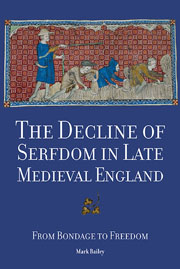Book contents
- Frontmatter
- Contents
- List of Maps
- List of Graphs
- List of Tables
- Acknowledgements
- Abbreviations
- Part I The Decline of Serfdom: Questions and Approaches
- Part II Case Studies
- 5 Reassessing the Decline of Serfdom: Methods and Sources
- 6 Walsham-le-Willows
- 7 Merton College, Oxford
- 8 Aldham
- 9 Tingewick and Upper Heyford
- 10 The Abbot of Bury St Edmunds
- 11 The Dukes of Norfolk
- 12 Miscellaneous manors
- Part III Conclusions
- Appendix: List of original sources used in this study
- Chronology
- Bibliography
- Index
9 - Tingewick and Upper Heyford
from Part II - Case Studies
Published online by Cambridge University Press: 05 March 2014
- Frontmatter
- Contents
- List of Maps
- List of Graphs
- List of Tables
- Acknowledgements
- Abbreviations
- Part I The Decline of Serfdom: Questions and Approaches
- Part II Case Studies
- 5 Reassessing the Decline of Serfdom: Methods and Sources
- 6 Walsham-le-Willows
- 7 Merton College, Oxford
- 8 Aldham
- 9 Tingewick and Upper Heyford
- 10 The Abbot of Bury St Edmunds
- 11 The Dukes of Norfolk
- 12 Miscellaneous manors
- Part III Conclusions
- Appendix: List of original sources used in this study
- Chronology
- Bibliography
- Index
Summary
Tingewick (Buckinghamshire) is situated six miles west of Buckingham, and it was held by a middling Norman monastery – the priory of St Faith, Longueville – until 1391 when it was acquired by New College, Oxford. Upper Heyford (Oxfordshire) lies eight miles west of Bicester. In the first half of the fourteenth century it was part of the estate of Robert de Lisle, first Lord Rougemont, but from mid-century it was held jointly by his sister (Alice Seymour) and her husband. The reversion of the title to the manor was sold to New College in 1380, who duly acquired it upon Alice's death in 1382. The two manors thus had three main attributes in common: they were both large and classic manors containing a significant proportion of customary land; they were situated relatively close to each other; and they were both acquired around the same time by New College.
The particular interest in this case study is twofold. The first is to contrast the management of villeinage on two classic manors held by two very different landlords: one an absentee monastic landlord and the other an upper-ranking gentry lord. The second is to observe how, or if, New College then altered the approach to villeinage, and whether it tried to impose a uniform estate policy on its newly acquired manors. New College was itself a recent creation, founded in 1379 by William Wyckham, bishop of Winchester.
- Type
- Chapter
- Information
- The Decline of Serfdom in Late Medieval EnglandFrom Bondage to Freedom, pp. 148 - 168Publisher: Boydell & BrewerPrint publication year: 2014

